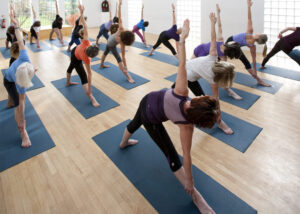What Is Sitkari Pranayama?
Sitkari pranayama, also known as the Sitkari breath, is one of the yoga breathing techniques found in the text “Hatha Yoga Pradipika.” The Sitkari breathing method is said to help reduce conditions such as mouth ulcers, effects of hunger, thirst, and laziness. One hisses through the teeth during inhalation and exhalation. The technique is also beneficial when it comes to preventing the increase of bile within the body. Sitkari Pranayama is cooling breathwork. As we shall see in the instructions, the tongue rests in a specific position in the mouth that allows cool air to pass through during inhalations, thus cooling down the body. Both the Sitkari and Sitali Pranayama are said to help with the imbalance of the Pitta Dosha – one of the aspects in Ayurveda that refers to the elements of metabolism, energy production, and digestion. The cooling pranayamas are best practiced during the heat. During warmer weather, our bodies are more susceptible to fatigue, overheating, tiredness, and lack of motivation.
Sitkari Pranayama Benefits
- Breathing exercises like Sitkari Pranayama do more than calm the body and mind. They help reduce stress and physical ailments. When the mind and body are stressed, your teeth may clench more – perhaps grinding your teeth at night – you may also feel tight in your muscles. The physical effect of stress is inflammation. Yoga helps reduce this inflammation by helping the muscles relax. For anyone who suffers from dehydration, yoga relaxes the jaw and produces saliva, which helps keep a dry mouth at bay. Of course, drink plenty of water too!
- Sitkari pranayama calms the eyes, ears, and body by stimulating the cooling mechanisms. It can help with burning eyes, stomach pain, and mild fever. In addition, Sitkari can be used to bring the body back to balance after high-intensity exercise.
- It can help relieve people who suffer from anxiety and hypertension. Some studies on Sitkari pranayama showed that it stalls down the brain waves and improves relaxation. Modern yoga passages recommend doing Sitkari pranayama before bed to quiet the mind and reduce insomnia.
- Sitkari lessens pitta in the body, reducing redness, inflammation, and other skin problems associated when the body is overheated.
- Poor posture, another common habit nowadays, can lead to the position of the lower jaw moving, malalignment of teeth, and TMJ disorders. Yoga helps you to correct your posture, which contributes to ease the strain from the jaw.
- Daily yoga improves the blood supply to the teeth and gums, resulting in healthy and strong teeth. The strength of our teeth relates to the power of our bones. The organ that drives the growth of bones is the pituitary gland. If your focus during practice is to relax your jaw and strengthen your teeth, try a posture or asana like Sirshasana, which activates more blood flow to the gland and thus supports the bones. Sirshasana is a challenging pose to do, so start with a trainer and gradually bring it into your Sitkari practice.
Sitkari Pranayama Technique
The name comes from the Sanskrit, Sitkari (Sit-ka-ri) indicating “supping” or “hissing”; prana, “energy” or “life”; and ayama, “prolong.” The Sanksrit term Sitkari from the ‘शीत्कारिन्’ (Shitkarin), notes to the ‘sound uttered while drawing the breath.’ The Hissing Breath in English is from the hissing sound that occurs during inhalation. The long inhales, exhales, and cooling effect during this breathwork help calm the body and mind when we feel an imbalance. As you may have concluded, the hissing sound comes from the sound made when doing the practice.
- Start by finding a nice place to sit in a meditation posture. Make sure that you are comfortable and can hold the pose for a long duration. Bring a yoga cushion with you. It can help keep the back straight and relieve pressure.
- Next, close your mouth so that your teeth are touching but not too clenched.
- Fold your tongue back and press against the teeth.
- Begin your inhalation by drawing the breath in nice and slowly. You will sense the coolness starting with the tongue. The cold air passes through the rest of your body and system.
- Let the breath out and exhale out through the nose.
- Repeat the cycle 3 times, then gradually bring your number to 5 and then 10 times.
- Sitkari does not have complicated variations. The only variation is to extend an additional breath as you hold the first inhalation and external breath retention to deepen the practice. You can also add bandhas (Throat and Root lock) if you feel like using a more advanced technique. Bandhas are “energetic locks.” You can stimulate them to strengthen your practice. They build more strength and stability in particular poses and are used with specific pranayama, or “breath control,” practices.
Sitkari Precautions
- Avoid doing the practice in a room with air conditioning or during cold seasons.
- People with low blood pressure should not try this breathing exercise.
- If you have a cold, sore throat, constipation, or asthma, it is best not to do this exercise.
- An alternative to Sitkari breathing is Sheetali. They have slightly different cooling techniques, and you can see which one you prefer to do.







